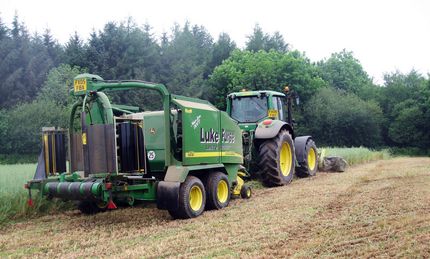From weed to valuable feed

Luke Furse runs an impressive contracting outfit. Aside from its agricultural activities, the firm undertakes big civil engineering projects as well as demolition, forestry, plus the construction of equine arenas and lakes.
But agriculture remains one of Mr Furse’s key business interests and one that continues to be a profitable source of income.
Based on the Devon/Cornwall border near Holsworthy, the company undertakes most of the work that is required by the area’s dairy and mixed farms.
Key to this is the silage gang, which is kept continuously busy from mid-April right through to October with three cuts of grass silage, wholecrop and maize.
Usually wholecrop is harvested using the firm’s Claas Jaguar 900 forager. But Mr Furse has taken a different approach over the last two years, particularly on his own organic ground.
“Since starting out with organic oats in 2002 we’ve tried to find the most effective ways of controlling grass weeds in the crop.
“It seems most spread from the field margins into the headlands. So, to combat this, we started topping off strips around the edge of each field before the weeds started to set seed.”
Realising that this was a waste of potentially valuable forage, he decided to look at the ways of harvesting the crop and hatched a cunning plan.
“Not wanting to compact the headlands with heavy kit, I looked at the tackle we already had,” says Mr Furse.
“Our baler/wrapper seemed the perfect tool to package up the cereal/grass mix and I couldn’t see why we shouldn’t keep it a one-pass operation.”
He reasons that as wholecrop cereals are usually harvested direct, there is no need to mow and bale as a separate operation.
A Claas Disco 3050 FC mower is hitched up to the front linkage of the John Deere 6920 used to pull the JD 678 baler/wrapper.
Six swipes are taken off the headland of each field of standing crop. The cut is taken about three weeks earlier than normal wholecrop silage to ensure the grain is caught at its most readily digestible.
“Because there is no kernel processor as there would be on a forager, we go in when the corn is still ‘cheesy’.”
Quaker porridge oats grown under contract receive this treatment, as do other cereal crops.
“Because of the success we’ve had with this technique as a means of keeping down weeds while producing valuable organic livestock feed, we’ve had a number of farmers – both organic and conventional – asking to perform the same operation on their land.”
As straw from the headlands tends to be shorter than usual it can easily be fed straight from the bale. Equally, Mr Furse points out that silage produced in this way is ideal for those producers using a mixer-wagon to dispense forage.
“Lightly mixed in the feeder wagon, nutritional advisers tell us the chop length is about perfect.
“The cattle wolf it down and that’s what it’s all about. Highly digestible, energy-rich fodder means the cows produce more milk and the beef cattle fatten faster – a real bonus, especially for organic producers.”

One pass with a baler/wrapper and mower up-front keeps down weeds in wholecrop cereals.
| One-pass wholecrop costs | |||
|---|---|---|---|
| £/ha | (£/acre) | £/bale | |
| Growing costs | £165 | (£68) | £3.33 |
| Mow | £20 | (£8) | 54p |
| Bale and wrap | £174 | (£71) | £4.70 |
| Sale value | £740 | (£300) | £20 |
| NB Figures based on 37 bales/ha (15 bales/acres) | |||
| Baled wholecrop advantages |
|---|
|

